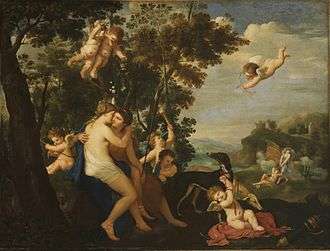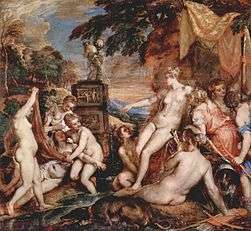Callisto (mythology)
.jpg)
In Greek mythology, Callisto or Kallisto (/kəˈlɪstoʊ/; Greek: Καλλιστώ [kallisˈtɔː]) was a nymph of Lycaon. Transformed into a bear and set among the stars, she was the bear-mother of the Arcadians, through her son Arcas.
The fourth Galilean moon of Jupiter is named after Callisto.
Origin of the myth
The name Kalliste (Καλλίστη), "most beautiful", may be recognized as an epithet of the goddess herself, though none of the inscriptions at Athens that record priests of Artemis Kalliste (Άρτεμις Καλλίστη), date before the third century BCE.[1] Artemis Kalliste was worshipped in Athens in a shrine which lay outside the Dipylon gate, by the side of the road to the Academy.[2] W. S. Ferguson suggested[3] that Artemis Soteira and Artemis Kalliste were joined in a common cult administered by a single priest. The bearlike character of Artemis herself was a feature of the Brauronia.

The myth in Catasterismi may be derived from the fact that a set of constellations appear close together in the sky, in and near the Zodiac sign of Libra, namely Ursa Minor, Ursa Major, Boötes, and Virgo. The constellation Boötes, was explicitly identified in the Hesiodic Astronomia (Αστρονομία)[4] as Arcas, the "Bear-warden" (Arktophylax; Αρκτοφύλαξ):[5]
He is Arkas the son of Kallisto and Zeus, and he lived in the country about Lykaion. After Zeus had seduced Kallisto, Lykaon, pretending not to know of the matter, entertained Zeus, as Hesiod says, and set before him on the table the babe [Arkas] which he had cut up.[6]
Aeschylus' tragedy Callisto is lost.
According to Julien d'Huy who used phylogenetical and statistical tools, the story could be a recent transformation of a Palaeolithical myth.[7]
Myth

As a follower of Artemis, Callisto, who Hesiod said[8] was the daughter of Lycaon, king of Arcadia,[9] took a vow to remain a virgin, as did all the nymphs of Artemis. But to have sex with her Zeus disguised himself as Artemis (Diana) herself, in order to lure her into his embrace. Callisto was then turned into a bear, as Hesiod had told it:
...but afterwards, when she was already with child, was seen bathing and so discovered. Upon this, the goddess was enraged and changed her into a beast. Thus she became a bear and gave birth to a son called Arcas.
Either Artemis "slew Kallisto with a shot of her silver bow,"[10] perhaps urged by the wrath of Juno (Hera)[11] or later Arcas, the eponym of Arcadia, nearly killed his bear-mother, when she had wandered into the forbidden precinct of Zeus. In every case, Zeus placed them both in the sky as the constellations Ursa Major, called Arktos (αρκτος), the "Bear", by Greeks, and Ursa Minor.
According to Ovid,[12] it was Jupiter (Zeus) who took the form of Diana (Artemis) so that he might evade his wife Juno’s detection, forcing himself upon Callisto while she was separated from Diana and the other nymphs.[13] Callisto's subsequent pregnancy was discovered several months later while she was bathing with Diana and her fellow nymphs. Diana became enraged when she saw that Callisto was pregnant and expelled her from the group. Callisto later gave birth to Arcas. Juno then took the opportunity to avenge her wounded pride and transformed the nymph into a bear. Sixteen years later Callisto, still a bear, encountered her son Arcas hunting in the forest. Just as Arcas was about to kill his own mother with his javelin, Jupiter averted the tragedy by placing mother and son amongst the stars as Ursa Major and Minor, respectively. Juno, enraged that her attempt at revenge had been frustrated, appealed to Oceanus that the two might never meet his waters, thus providing a poetic explanation for their circumpolar positions.
The stars of Ursa Major were all circumpolar in Athens of 400 BCE, and all but the stars in the Great Bear's left foot were circumpolar in Ovid's Rome, in the first century CE. Now, however, due to the precession of the equinoxes, the feet of the Great Bear constellation do sink below the horizon from Rome and especially from Athens; however, Ursa Minor (Arcas) does remain completely above the horizon, even from latitudes as far south as Honolulu and Hong Kong.
In popular culture
- In the television series Hercules: The Legendary Journeys and its spinoff Xena: Warrior Princess, Callisto is portrayed by Hudson Leick.
- In the video game Persona 2: Eternal Punishment, Callisto is the initial Persona of supporting character Ulala Serizawa.
- In the video game God of War: Ghost of Sparta Callisto is portrayed as the mother of protagonist Kratos and undergoes transformation into a monstrous beast that the player must defeat.
- In the video game The Secret World Callisto is the nickname of a quest giving NPC and the myth related to a puzzle/investigation quest.
- In music, the song "Like Callisto to a Star in Heaven" by American heavy metal band Trivium dramatically retells the myth of Callisto's rape, pregnancy, and exile.
References
- ↑ Daniel J. Geagan. "The Athenian Constitution After Sulla" (Hesperia Supplements 12 1967:72, 95).
- ↑ Klio: Beiträge zur alten Geschichte (Deutsche Akademie der Wissenschaften zu Berlin Institut für Griechisch-Römische Altertumskunde) 1907.
- ↑ In Klio 7 (1907:213f).
- ↑ Hesiod, Astronomia, fragment 3, preserved as a quote in a commentary on Aratus.
- ↑ Thus Hesiod is quoted, though Boötes, Βοώτης, from his very name, is a cow (βοως) herdsman.
- ↑ The episode is a doublet of the serving up of Pelops.
- ↑ d'Huy Julien, Un ours dans les étoiles: recherche phylogénétique sur un mythe préhistorique. Préhistoire du sud-ouest, 20 (1), 2012: 91-106 ; A Cosmic Hunt in the Berber sky : a phylogenetic reconstruction of Palaeolithic mythology. Les Cahiers de l'AARS, 15, 2013: 93-106 .
- ↑ In his lost Astronomy, quoted in Catasterismi.
- ↑ Other writers gave her a mortal genealogy as the daughter of one or the other of Lycaon's sons: Pseudo-Apollodorus, Bibliotheke.
- ↑ Homerica, The Contest of Homer and Hesiod, 316 ff (trans. Hugh G. Evelyn-White).
- ↑ This was the version current in Greece when Pausanias visited in the second century CE (Pausanias, VIII.35.8).
- ↑ Ovid. Metamorphoses. Book II, Lines 405–531; Ovid narrates the myth also in Fasti, book II.
- ↑ The transformation of Zeus, with its lesbian overtones, was rendered as comedy in a lost work by the Attic Amphis (Theoi Project – Kallisto).
Further reading
- Pseudo-Apollodorus. Bibliotheke III.8.2.
- Hyginus, attrib., Poeticon astronomicon, II.1: the Great Bear.
External links
| Wikimedia Commons has media related to Callisto (mythology). |
- Hesiod, Astronomy, quoted by the Pseudo-Eratostenes, Catasterismi: e-text (English)
- Theoi Project – Kallisto
- Richard Wilson's 'Landscape with Diana and Callisto' at the Lady Lever Art Gallery
- Warburg Institute Iconographic Database (ca 175 images of Callisto)